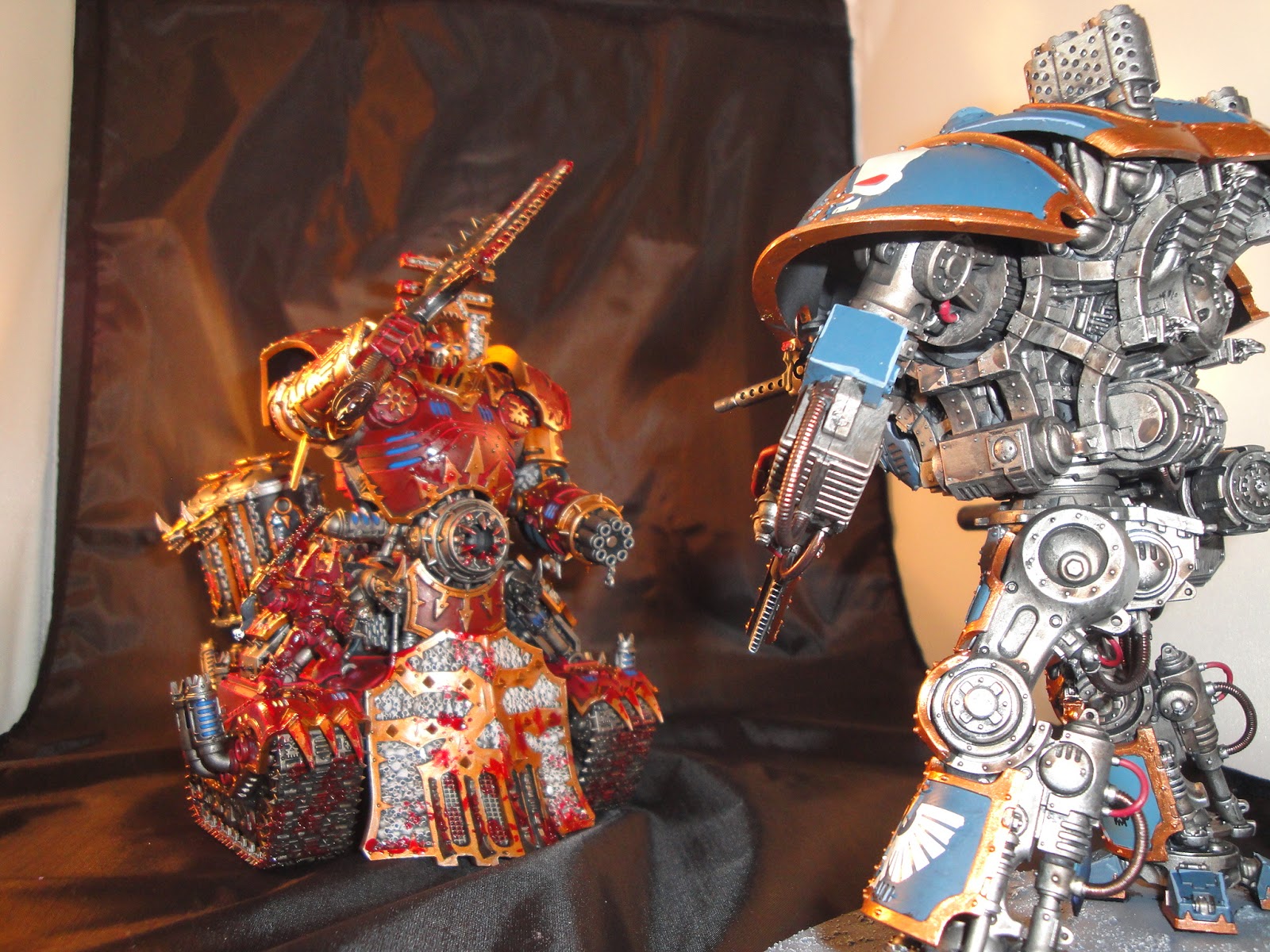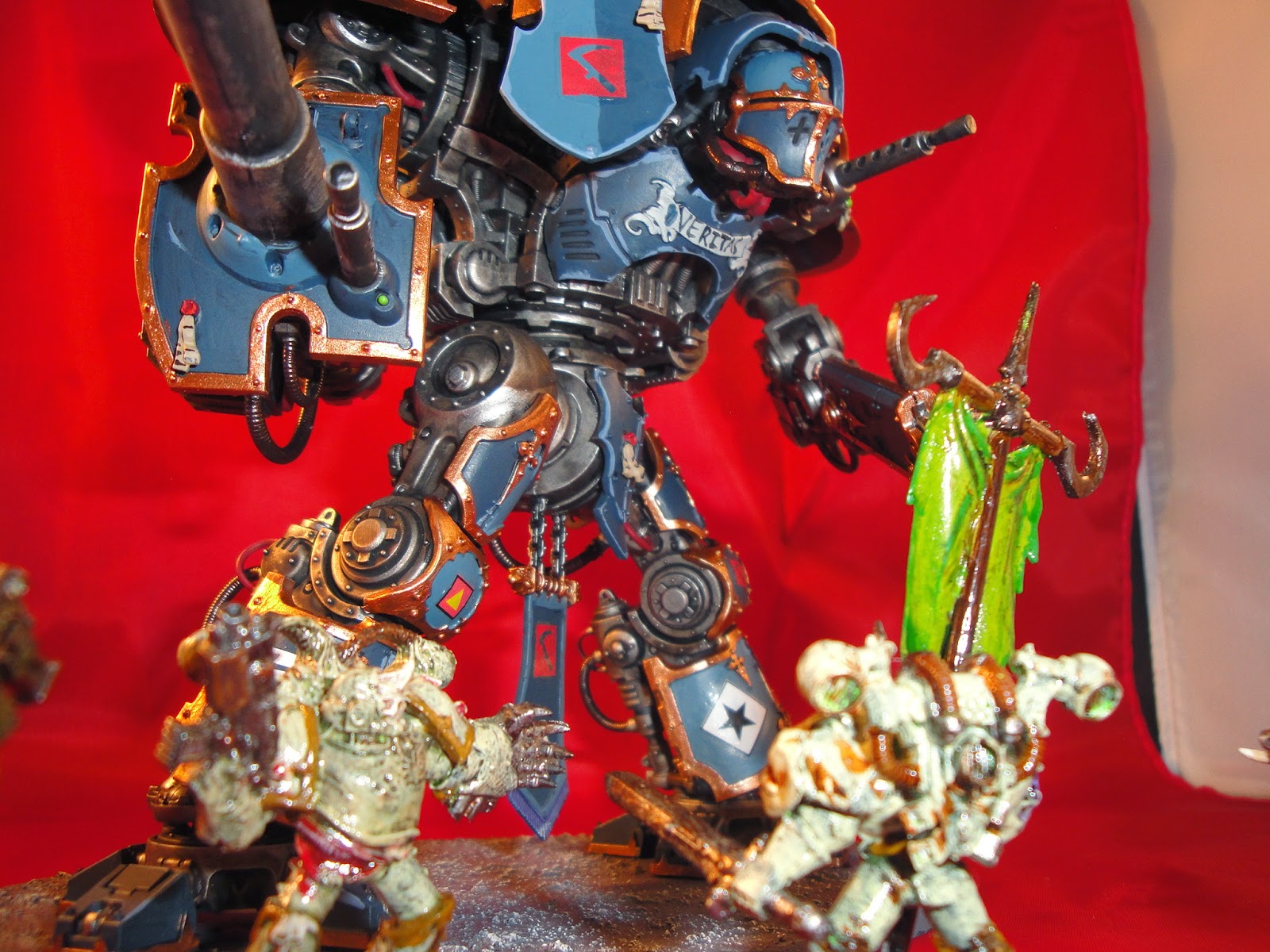I am weak.
When I first heard about the Knights- I said meh. Even though I have been rebooting my Ultramarines even as I continue building my Khorne Bezerker warband, I heard about the Knight and said "Sounds good, but I don't know if I need it". The rumor was there was to be no Chaos version (or rules for conversions that us Chaos guys love to do). Did my Ultramarines need a super-heavy? I was certainly curious about it, but I decided that I would not get one.
Then, I saw the damn thing. How could any Warhammer 40K fan not love that model? Holy cow- what a look. What a design. I fell in love immediately (sorry wifey!). I knew that I had to have one... But, could I spend $140 plus tax? My semi-local didn't help, tempting me with a $120 price tag... Oh cruel temptation!! I looked sheepishly at my wife and... well, she clearly loves me enough to indulge in my particular habit- though she said I couldn't buy a new model for a while (Though I love the new Helbrute- do I really need that right now? I have more Dreadnoughts than I know what to do with!). So, with my pusher... er... friendly hobby store owner looking at me knowingly, I caved in and bought the Imperial Knight.
I want to tell my Freeblade's story, but I want to just go into the paint scheme. I wanted something blue, but not Tzeentch blues or Ultramarine blue. I needed something different. I decided to go with Stegadon Scale Green as the basecoat. I loved it so much, that I decided that would be the primary color. I then used Thunderhawk Blue for the contrasting plates, with Russ Grey as an edge highlight. The effect is to make it a blue war machine, but not too bright. To me, it was the perfect mix of blues- looking like nothing I have ever done before. The trim is Balathazar Gold base and Hapshut Copper over it. The metal was typical- Leadbelcher, Nuln Oil all over, Ironbreaker dry brushed, Eathshade in various spots, and finally Runefang on a few select parts. As for the decals that I used- I liked some of the ones on the sheet, but frankly, I wanted something unique (but I suck at freehand)- so I used the scythe from the Imperial Guard sheet as his main symbol, with a skull motif for most of the decals. I do love the huge skull ones from the Imperial Knight decal sheet though, so I had to use them.
Overall, I am thrilled with how this guy came out. He looks totally unique- I have never painted anything remotely in those colors. The decals added that final touch, making the whole thing really stand out. I am looking forward to fielding this bad boy. So, who is this Freeblade... let's look at the sad yet heroic background of this mighty Knight...
The Knightly House of Dilabor was known for its brave and unflinching Knights. House Dilabor had been loyal to the Imperium since the days of the Great Crusade, when the world was found by the Ultramarines in the Ultima Segmentum. The lords of Dilabor quickly recognized the wisdom, strength, and statesmanship of Guilliman (who met the lords personally, or so legends say), and swore allegiance to the warriors of Ultramar and the Emperor whom they served. During the Heresy, they came to the aid of the Ultramarines time and again, fighting the depredations of the Word Bearers and World Eaters during the Shadow Crusade.
At the conclusion of the Heresy, the Knights of House Dilabor sent their knights far and wide, aiding Guilliman in the defense of the Imperium during the Scouring. Indeed, their were only a handful of knights left on their homeworld, such was their dedication. During the Scouring, the Lord Prime of the House of Dilabor himself, Zyknos the Great, led a contingent of seven Knights alongside the White Scars and the Ultramarines against the marauding forces of the traitorous Death Guard. Legend has it that Lord Prime Zyklos had Mortarion himself in his sights, and the battle was joined- Primarch versus Knight. The day seemed to belong to Zyklos, but through some foul trickery, the Death Lord was able to escape with his wretched life. It is told that Mortarion cursed Zyklos, and swore to bring ruin upon the House of Dilabor one day, even if it took an eternity.
Zyklos brought great honor to his House that day, and in the days that followed. However, when he returned finally to his howeworld and his keep- The Domain of Vereor, he discovered the tragic price of his House Dilabor's increased honor- almost all of his Knights were killed in their battles in The Scouring, including his beloved eldest son, Hansius. Legend tells that Zyklos was broken by the grief- he removed all the colorful tapestries, elegant statues, and magnificent paintings from Vereor. He ordered that forevermore the Domain will be blackened, and the names of the dead were to be venerated for all time. Thus began the tradition of Dilabor Tristis- a ceremony for the fallen, so lengthy, so ponderous, so depressing, surpassing any and all other such House traditions.
Thus, it went on for millennia, with the descendants of Zyklos maintaining the somber traditions set forth by Zyklos. Even though the Mechanicum awarded Dilabor with more Imperial Knights than they had before, the pain of the loss was always within the House- never to be forgotten. Through the proceeding centuries, House Dilabor continued to be known for their bravery and sacrifice, though their attitude in fighting was less than joyous, unlike other Knights who revel in their power. It seemed the Knights of House Dilabor had a grim determination to do their job, and nothing more.
In the 41st Millenium, the Lord Prime of Dilabor (and direct descendant of Zyklos himself) Pecatus the Questing. Pecatus continued the Dilabor tradition of aiding all who came asking for the Knights to defend their worlds, just as he continued the tradition of Dilabor Tristis. Pecatus had just married his consort, and was actually content (something most Knights of Dilabor never were). One day, the Ultramarines petitioned Dilabor for aid against the Tyranids of Hive Fleet Behemoth. In order to prove his bravery to his beautiful consort, Pecatus himself led a contingent of Knights against the Xenos menace. Upon the defeat of the Tyranids, Pecatus returned home to find his consort dying of an incurable illness. He arrived just in time to watch his young bride die in his arms. Pecatus was immediately reminded of the plight of his forebear, and decreed that his wife will be forever remembered in the Grand Tristis- a ceremony lamenting his wife. The Lord Prime thus fell into a morose, grieving state, refusing even to take to his Knight to joust or make war. It was like this for a decade and more. The lords of House Dilabor, sworn in allegiance to their Lord Prime, could do nothing to assuage their master's guilt and sadness. Even Pecatus' brother, Fedelo, could not rouse his brother.
Then, one day, a Ecclasiarch Bishop came to the homeworld, for the world of House Dilabor were incredibly faithful to the Imperial Creed. The Bishop sought out Pecatus, only to find the Prime Lord inconsolable. The Bishop remained for seven months, when he asked to see Pecatus again. The Bishop reminded Pecatus that all things pass and that all things die. The Bishop suggested that the Lord Prime create even more ceremonies to honor all the fallen of Dilabor. Pecatus was impressed that the Bishop seemed to understand his pain, and he followed the Bishop's advice, making an even grander and more tragic Tristis ceremony. This litany for the dead grew ever longer and more ponderous, with the Bishop adding even more sad memorials with Pecatus' approval.
The influence of the Bishop grew more and more over the miserable Lord Prime, and the lesser lords were torn. Some supported their liege lord and his Bishop, while other lords, including Fedelo, began to resent the Bishop's influence. However, the situation worsened when the Ultramarines once again petitioned House Dilabor for aid to fight a new Tyranid incursion. The Bishop counselled that Petacus should not be so quick to respond, lest he suffer the same fate as his ancestor. The Bishop suggested that the Ultramarines fight their own battles. Thus, the Lord Prime rejected the call, keeping his Knights on the homeworld. His brother was furious- demanding an explanation, to which his brother replied "All things die. It matters not when or how. By the slow march of time or the claws of the Xenos. All things die in the end. Why struggle so"? Instead of fighting, Petacus called for a new ritual to honor the fallen, with symbols and words strange to the ears of the gathered lords- words introduced by the Bishop.
This pattern continued for a year, until Fedelo and his allies could bear it no more- they demanded that Petacus change his course and restore honor to the House. The Bishop called it treachery, and urged the Lord Prime to fight the dissenters. Thus, began the conflict that tore House Dilabor asunder. Knight against Knight- the homeworld became a slaughterhouse, where innocent peasants died in the hundreds of thousands in the crossfire.
In an attempt to break the stalemate, Fedelo and his Knights massed to charge the Domain Vereor. As this last stand progressed, Petacus' Knights were faltering. At this moment, the Bishop played his last hand- in the midst of battle, he strove onto the battlefield and used sorcerers warp power against the Knights-n and it stood revealed that the Bishop was a scion of Chaos- a devoted follower of the god Nurgle. Even Petacus, who was so under the sway of the Bishop, was horrified at the truth- his loyal confidant was in fact a foul denizen of the ruinous powers.
What happened next is all conjecture. The battle raged- but when the smoke cleared, the corrupted Bishop was slain, and only one Knight stood. The Knight quickly disappeared- leaving behind wrecked Knights and a world that would now struggle to survive the wounds inflicted upon it by its own House. Not long thereafter, this solitary Knight reappeared in battle next to the Ultramarines, as if fulfilling the old oaths of Dilabor once more. The Knight was called Veritas.
Who is Veritas? Some believe that it is Fedelo, fighting on to restore the honor of his fallen house. Others claim that it is Petacus himself, who is now fighting not just to restore honor for Dilabor, but also to redeem himself. Or is there another explanation? No one knows the truth, just as no one has seen the man within the Imperial Knight. Thus Veritas has always appeared to help the loyal forces of the Imperium- unasked for, but always decisive, and always welcomed by the armies of the Emperor, and yet as silent as the grave.
So, that's the background for my Freeblade. Hope you've enjoyed the story and the pics. And yes, I am weak... I'm trying to resist buying that sexy Hellbrute...

















No comments:
Post a Comment